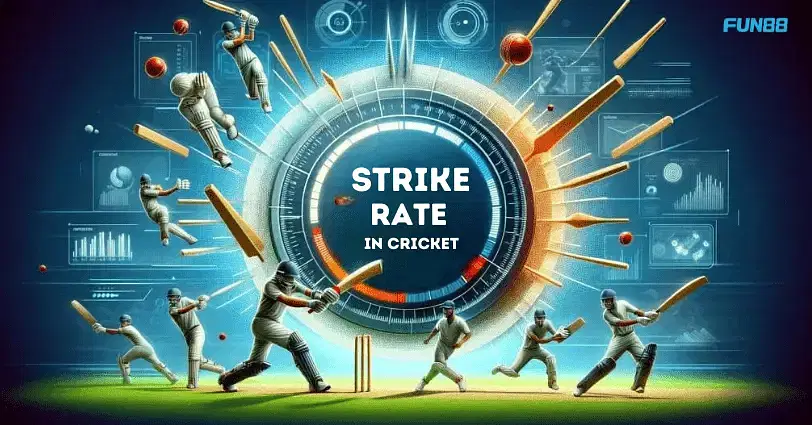How to calculate strike rate is essential for cricket enthusiasts and players alike. In cricket, the strike rate measures a player’s performance, indicating how many runs they scored per 100 balls faced. It is a crucial statistic for both batsmen and bowlers as it provides a quick and easy way to evaluate a player’s effectiveness in the game.
The calculation of strike rate is relatively simple, and a proper understanding of it can provide valuable insights into a player’s performance. In this blog, we will help you understand the concept of strike rate and provide you with the cricket strike rate formula for both batters and bowlers. Let’s look at how to calculate the strike rate.
What is Strike Rate in Cricket?
The strike rate is a crucial statistic in cricket, primarily in ODIs and T20s. It measures the number of runs scored by a batsman per 100 balls faced. A high strike rate indicates that the batter scores runs at a brisk pace, while a low strike rate suggests that the batter doesn’t have an aggressive approach.
How to Calculate Strike Rate in Cricket?
Calculating the strike rate is a simple process that involves dividing the number of runs scored by the number of balls faced and multiplying the result by 100.
Here’s how to calculate the strike rate:

For example, if a batter scores 50 runs in 40 balls faced, the strike rate would be calculated as follows:
Strike Rate = (50 / 40) x 100 = 125
Therefore, the batsman’s strike rate is 125.
A batter must face at least ten deliveries to calculate the strike rate.
Why is Strike Rate Important?
The strike rate is a critical statistic in limited-overs cricket as it measures the batsman’s ability to score runs quickly and efficiently. In T20s, a high strike rate means the batsman scores rapidly and puts pressure on bowlers.
In ODIs, the strike rate is also essential as it allows the batsman to build momentum and pressure. In addition, a high strike rate in ODIs can help the batter to accelerate the run rate and set big scores or chase down targets quickly.
We have covered how to calculate strike rate. Now let’s focus on batting strike rate.
Factors Affecting Strike Rate in Cricket
Several factors can impact the strike rate of a batsman. Below are a few of them:
Match Situation:
The match situation plays a crucial role in determining the strike rate of a batsman. If the team is chasing a big total, the batter may have to take more risks and score quickly.
Pitch Conditions:
The pitch conditions can also impact the strike rate. If the pitch is slow, it may be challenging to score runs quickly, leading to a lower strike rate. But if it is a flat track, the batter may find it easier to score runs.
Bowling Attack:
The quality of the bowling attack the batsman faces can affect the strike rate. Some bowling attacks are known for their aggression, while others for their accuracy and consistency.
A batsman facing an aggressive bowling attack might struggle to score runs freely and have a lower strike rate. On the other hand, if a batsman is facing a relatively weak bowling attack, they tend to score at a higher strike rate.
Batsman’s Form:
A batsman’s form is also an essential factor that can impact their strike rate in cricket. If a batter is in good form, they are likely to score more freely and have a higher strike rate. However, an out-of-form batter will struggle to score runs at a good pace.
Strike rate is not the only measure of a batsman’s performance; factors such as the quality of the opposition, match conditions, and the game situation can also affect a batter’s strike rate.
The strike rate can also vary depending on the role of the batter in the team. A top-order batsman is expected to score quickly and may have a higher strike rate than a lower-order batter, who primarily rotates the strike and supports the more aggressive batter.
Players with the Highest Batting Strike Rate in ODI
Following is the list of players with the highest Batting strike in ODI:
| Player | Innings | Runs | Balls Faced | Batting Strike Rate |
| Andre Russell | 47 | 1034 | 794 | 130.22 |
| Glenn Maxwell | 117 | 3490 | 2796 | 124.82 |
| Jos Buttler | 138 | 4647 | 3939 | 117.97 |
| Lionel Cann | 25 | 590 | 504 | 117.06 |
| Shahid Afridi | 369 | 8064 | 6892 | 117 |
*Stats as on August 4, 2023
Bowling Strike Rate in Cricket – How to Calculate it?
The term “strike rate” is also used for bowlers. A bowler’s strike rate indicates how frequently the player takes a wicket. You can calculate bowling strike rate it by dividing the number of balls bowled by the number of wickets the bowler takes.
Here’s how to calculate strike rate for bowlers:

For example, if a bowler has bowled 600 balls and taken 30 wickets, then his strike rate would be:
Strike Rate = 600 / 30
Strike Rate = 20
The bowler takes a wicket every 20 balls.
A low strike rate for a bowler is a good sign, as it indicates that the bowler is taking wickets regularly. However, a bowler’s strike rate should be considered with other factors such as the bowler’s economy rate, bowling average, and the types of pitches and conditions they are bowling in.
The strike rate is also used as a tiebreaker in some tournaments. For example, in the Indian Premier League (IPL), if two teams have the same number of points at the end of the group stage, the team with the better net run rate, and if the net run rate is the same, the team with the better overall bowling strike rate is ranked higher.
Players with the Highest Strike Rate in ODI
Here is the list of players that has the highest strike rate in ODIs:
| Player | Matches | Wickets | Balls | Bowling Strike Rate |
| RJ Harris | 21 | 44 | 1031 | 23.43 |
| S Lamichhane | 49 | 111 | 2690 | 24.23 |
| Bilal Khan | 45 | 95 | 2346 | 24.69 |
| Corey Anderson | 49 | 60 | 1485 | 24.75 |
| MA Starc | 110 | 219 | 5676 | 25.91 |
*Stats as on August 4, 2023
Wrapping up
The strike rate is a valuable statistic for evaluating a player’s performance in cricket, and it can provide insights into their strengths and weaknesses. By understanding how to calculate the strike rate and the factors that influence it, fans and analysts can gain a deeper appreciation for the sport and the players who excel at it.
Stay tuned to Fun88 blog to get more information on How to Calculate Strike Rate Formula in Cricket
You can also Read about Bowling Average Formula Blog in our Website.
FAQs on How to Calculate Strike Rate
1.What is a good strike rate for a bowler in cricket?
A good strike rate for a bowler in cricket depends on the format of the game. In Test cricket, a strike rate of less than 50 is considered good, while in ODIs, a strike rate of less than 35 is considered good. In T20, a strike rate of less than 20 is excellent.
2.Who holds the record for the best strike rate among bowlers in ODI?
The record for the best strike rate among bowlers in ODI is held by Nepal’s Sandeep Lamichhane, who has a strike rate of 22.8.
3.How to calculate strike rate for bowlers in cricket?
The strike rate for bowlers in cricket is calculated as the average number of balls bowled per wicket taken.
Star it if you find it helpful.

